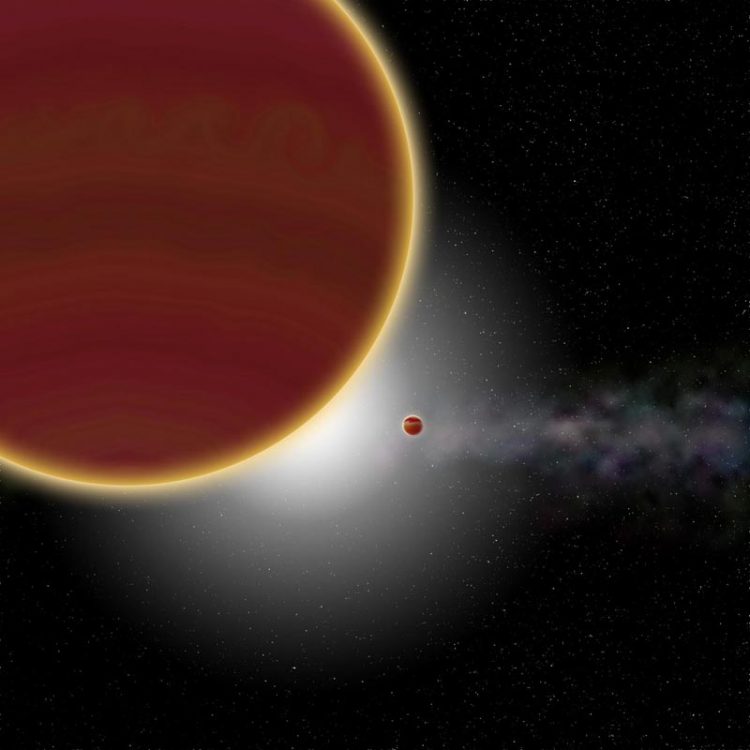A second planet in the Beta Pictoris system

At least two giant planets, aged 20 million years at most, orbit around the star (which is hidden): β Pictoris c, the nearest one, which has just been discovered, and β Pictoris b, which is more distant. The disk of dust and gas can be seen in the background. Credit: P Rubini / AM Lagrange Usage Restrictions: May only be used with appropriate credit and caption, to report on this research.
The β Pictoris system has fascinated astronomers for the last thirty years since it enables them to observe a planetary system in the process of forming around its star.
Comets have been discovered in the system, as well as a gas giant, β Pictoris b, detected by direct imaging and described in 2009 by Lagrange's team.
This time, the team had to analyse more than 10 years of high-resolution data, obtained with the HARPS instrument at ESO's La Silla Observatory in Chile, in order to indirectly detect the presence of β Pictoris c (2).
This second giant planet, which has a mass nine times that of Jupiter, completes its orbit in roughly 1,200 days, and is relatively close to its star (approximately the distance between the Sun and the asteroid belt, whereas β Pictoris b is 3.3 times more distant).
The researchers hope to find out more about the planet from data from the GAIA spacecraft and from the future Extremely Large Telescope now under construction in Chile.
Notes
(1) The team includes researchers from other French laboratories – Lagrange laboratory (CNRS/Observatoire de la Côte d'Azur/Université Côte d'Azur), Laboratoire d'études spatiales et d'instrumentation en astrophysique (CNRS/Observatoire de Paris – PSL/Sorbonne Université/Université de Paris), Institut d'astrophysique de Paris (CNRS/Sorbonne Université) – as well as researchers from the Max Planck Institute for Astronomy (Germany), the South African Astronomical Observatory, the University of Warwick (UK), Leiden Observatory (the Netherlands), European Southern Observatory, Universidad de Chile and Universidad de Valparaiso (Chile).
(2) The method used was the radial velocity method: planets and stars orbit around a common centre of gravity which is usually located within the star. Thus, in the presence of a planet, the star describes orbits that are very small but nonetheless detectable by the radial velocity method, which is based on the Doppler effect (its light spectrum shifts alternately towards blue and red). Since β Pictoris is a relatively massive star (almost twice the mass of the Sun) that undergoes considerable pulsations (its size varies periodically), the signal obtained is extremely complicated, and it was first necessary to subtract the effect of the pulsations. In fact, this is the first time that a planet has been detected around such a star using this method.
Media Contact
All latest news from the category: Physics and Astronomy
This area deals with the fundamental laws and building blocks of nature and how they interact, the properties and the behavior of matter, and research into space and time and their structures.
innovations-report provides in-depth reports and articles on subjects such as astrophysics, laser technologies, nuclear, quantum, particle and solid-state physics, nanotechnologies, planetary research and findings (Mars, Venus) and developments related to the Hubble Telescope.
Newest articles

A ‘language’ for ML models to predict nanopore properties
A large number of 2D materials like graphene can have nanopores – small holes formed by missing atoms through which foreign substances can pass. The properties of these nanopores dictate many…

Clinically validated, wearable ultrasound patch
… for continuous blood pressure monitoring. A team of researchers at the University of California San Diego has developed a new and improved wearable ultrasound patch for continuous and noninvasive…

A new puzzle piece for string theory research
Dr. Ksenia Fedosova from the Cluster of Excellence Mathematics Münster, along with an international research team, has proven a conjecture in string theory that physicists had proposed regarding certain equations….



